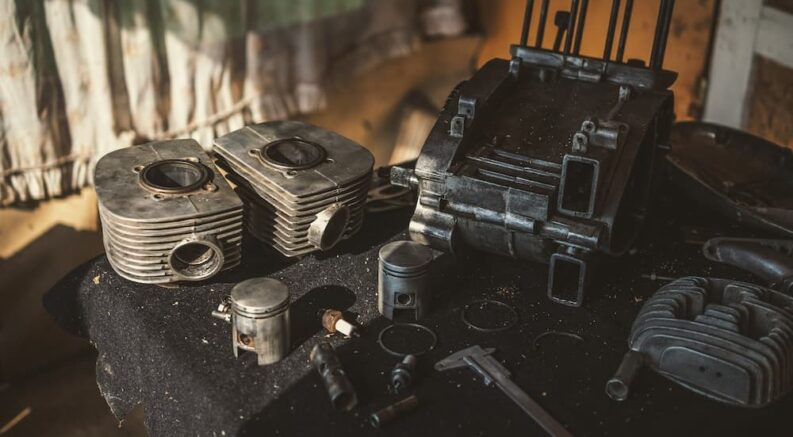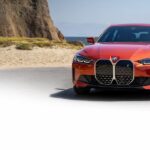In many respects, the evolution of motorcycle engines has been straightforward. Internal combustion piston engines established themselves as the predominant engine type by the early 1900s, and most designs—two-stroke, four-stroke, parallel-twin, V-twin, etc—have built on this. Along the way, horsepower and torque kept going up, just like with cars.
But in the book of motorcycle engine history, there are a few eccentric, bizarre, and downright weird chapters. With Halloween upon us, I wanted to revisit some of the odd motorcycle engines that have graced roads and tracks. From failed technologies to niche applications, the stories of these powerplants will give you a devilish look beyond the conventional.
Honda CBX I-6
Compared to automobiles, six-cylinder engines in motorcycles are unusual. Even by that standard, the engine in the Honda CBX inline-six stands out as being a bit off-kilter, with the two-foot-long engine protruding from either side of the bike. This motor was in the Honda CBX superbike, sometimes called the CBX 1000, made from 1978 to 1982. Adapting engine tech from the Honda RC GP Racing bike of the 1960s, the CBX I-6 was an unapologetic brute. At 1,047cc with 24 valves and six carburetors, it had up to 105 hp and 63 lb-ft of torque, reaching a top speed of 140 mph.
Such an engine was appropriate for a motorcycle once described as glam-rock on two wheels. The Honda CBX I-6 got excellent reviews, but when the Honda CB900F with its more compact I-4 came out in late 1979, it quickly outpaced its big brother in sales. Between this and increasing criticism about emissions, Honda tried multiple times to give the bike a facelift and even made a desperate attempt to reposition the bike as a tourer. Nothing could drive sales up, though, and the CBX 1000 with its I-6 was discontinued after 1982, though it has retained a cult status over the decades.
Hercules W-2000 & Suzuki RE5 Rotary
Despite the appeal of packing massive power in a compact size, rotary engines—also known as Wankel engines after the German engineer who invented them—have never caught on with motorcycles or cars. Among other things, rotary engines burn more fuel and oil than piston engines, run hotter, and need to be rebuilt sooner.
That hasn’t stopped a host of motorbike manufacturers from trying to make rotary engines work. The most notable attempts were by Hercules and Suzuki in the mid-1970s. After a failed effort by Motorrad Zschopau, the Hercules W-2000 became the first production motorcycle to use a rotary engine when it was released in 1974. It used a 294cc Sachs KM-914 powerplant originally made for snowmobiles that could produce up to 32 hp and 24 lb-ft of torque. However, the bike never caught on with critics or the public and was discontinued in 1977. Reportedly, Hercules was selling 40 fewer units a month than it needed to make a profit.
Months after the W-2000 debuted, Suzuki crashed the party with the RE5 Rotary. Its 497cc Wankel engine was nearly double the size of the Sachs KM-914, clocking in at 62 hp and 56 lb-ft of torque. Design-wise, the Suzuki RE5 Rotary resembled the two-stroke GT750 with a few modifications. Suzuki invested heavily in the RE5 Rotary, even funding a new assembly line for the engines. Like the W-2000, though, customers greeted it coolly, partly because the motorcycle was very heavy and complex. Suzuki finally cut its losses and scrapped the bike in 1976.
Honda RC211V V5
If you think the failure of the CBX 1000 discouraged Honda from trying out wacky motorcycle engine designs, think again. In 2002, it rolled out a true oddity: a V5 powerplant. While it seems strange on paper, there were legitimate reasons for this direction. The organizers of Grand Prix motorcycle racing decided transitioning from two-stroke to four-stroke engines in their headline class was long overdue. As such, for the 2002 season, they decreed that while two-stroke engines would stay capped at 500cc displacement, teams could now run four-stroke engines with up to 990cc (they also rebranded the class as MotoGP, the name still used today).
Most constructors took advantage of the opportunity to switch to four-stroke powerplants, but the Honda RC211V was the most intriguing. The rules said four-stroke engines could have anywhere from three to six cylinders, and Honda used factors like powerband, balance, weight, and reliability to determine that five was the magic number. The initial RC211V made 200 hp from its dual-overhead cam design; further upgrades led to the engine reaching 240 hp in 2003 and eventually peaking at 260 hp.
When added to a lightweight, responsive bike, the V5 was an immediate hit. Valentino Rossi won back-to-back MotoGP championships for Honda in 2002 and 2003 on the RC211V, and Honda won three straight constructor’s championships from 2002 to 2004. Honda took back the constructor’s title in 2006, with Nicky Hayden earning the rider championship. It was the last ride for the RC211V V5, though, as MotoGP switched to an 800cc engine capacity for 2007. This led to the bike and engine being replaced by the Honda RC212V V4.
MTT Y2K Turbine Superbike
Another motorcycle engine type that hasn’t seen much mainstream success is the gas turbine engine. While extremely successful in aircraft, ships, and generators, its sheer inefficiency, ultra-high idling RPMs, extreme noise, and high production costs make the turbine impractical for mass car and bike production.
Turbines have found a niche, though, thanks to Marine Turbine Technologies. Named for its year 2000 launch, the Y2K Turbine Superbike series was the first street-legal motorcycle using turbine engine technology, and it remains the most powerful. Early models used refurbished Rolls-Royce 250-C18 helicopter engines that made 320 hp, reaching a top speed of 227 mph. They later switched to the Rolls-Royce 250-C20B, which delivers 420 hp at 52,000 RPM (no, that is not a typo).
Interestingly, turbines can be easily modified to use many different types of fuel. Made-to-order Y2K Turbine bikes have used biofuel, kerosene, diesel, and regular pump gasoline. Want an even crazier turbine motorcycle engine? Check out the MTT 420-RR. Advertised as a race-ready superbike, it has a claimed top speed of 273 mph, leaving manufacturers from Kawasaki to Ducati in the dust.
Chevrolet V8 Widowmaker 7
I thought it appropriate to end with arguably the most infamous “motorcycle” engine. The brainchild of E.J. Potter—known in drag racing circles as “The Michigan Madman”—the Widowmaker succeeded where few others could, adding an automobile engine to a motorcycle. The earliest version of the Widowmaker in the early 1960s had a Chevrolet 283 small-block V8 sitting across a modified Harley-Davidson frame. Potter used a drive chain to link the engine to the transmission.
By 1971, the Michigan Madman had achieved his pièce de résistance with Widowmaker 7. It now had a modified Chevrolet 350 5.7L V8 engine using 12.5:1 forged pistons, custom fuel injection, aluminum heads, and more to help it reach 500 hp. To get maximum torque on the drag strip, Potter would rev the engine while the bike was on a kickstand, then push off when he reached 7,500 RPM. It worked—Widowmaker 7 was recognized by the Guinness Book of World Records in 1973 as the world’s fastest motorcycle when it completed a quarter-mile run in 8.68 seconds, reaching a top speed of 172 mph.
Let Bizarre Engines Howl
Plenty of other oddball motorcycle engines have been attempted beyond what’s here. From motorcycles that run on diesel to satisfy military contracts to the new Levis 1200cc V6 Cafe Racer with a rare sequential firing order, people are always trying to come up with the next big thing. The first motorcycles ran on steam engines, and with recent efforts at hybrid bikes plus the insatiable drive of aftermarket modders, more engine curiosities are bound to pop up. Some will succeed, while others will be left as historical footnotes—but I appreciate these novelty stories as much as the mainstream tales, and I hope you do, too.




